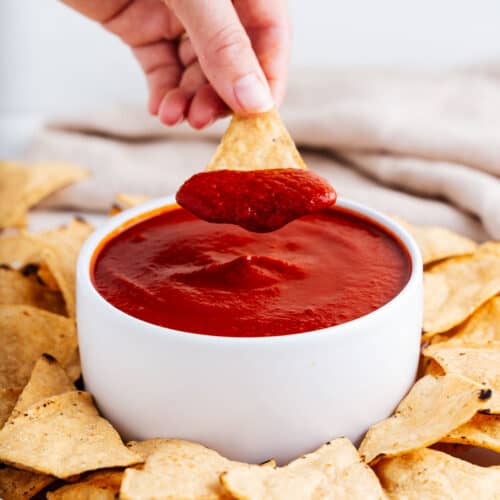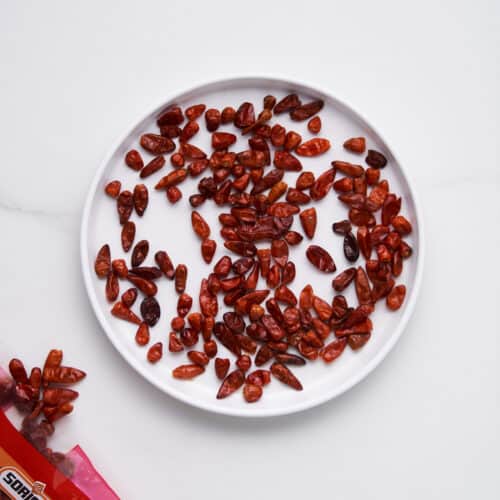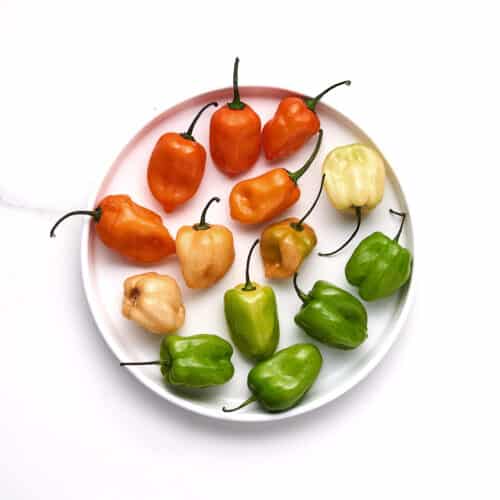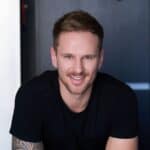Cascabel Chile
The cascabel chile (or chile cascabel) is a unique dried Mexican pepper that looks like a bell and sounds like a rattle. This guide covers everything you need to know, including what it is, its flavor profile, storage tips, and how to prepare it for recipes.

What are cascabel chiles?
Cascabel chiles are a unique variety of mirasol chiles known for their round shape and the rattling sound their seeds make when shaken. In Spanish, “cascabel” means “little bell” or “rattle, ” which is very fitting.
Along with guajillo peppers, they are part of the Capsicum annuum species. More specifically, they form part of the mirasol family. Mirasol chiles grow pointing up towards the sky rather than hanging down like most other chiles — hence why their name is “mirasol,” which means “facing the sun.”
Cascabel chiles are native throughout the entire country of Mexico, but they are primarily grown in the states of Guerrero, Durango, Coahuila, Jalisco, and San Luis Potosi. When used in cooking, they contribute a beautiful color and a complex flavor profile that enhances the depth of marinades, stews, and salsas.
Flavor profile
Cascabel chiles are well-known for their rich, nutty flavor with smoky and earthy undertones. They impart a deep, rounded heat to dishes rather than an intense, sharp spiciness.
Some cooks also say they have a mildly fruity taste, ranging from cherry to dried fruit. Their balance between spice and flavor makes them a popular choice for making salsas, sauces, and stews where a robust yet not overwhelming taste is needed.
Spice level
Cascabel chiles are relatively mild compared to other chiles, measuring 1,500-2,500 Scoville Heat Units (SHU) on the Scoville scale.
To put this into perspective, they are milder than jalapeno peppers, which average about 2,500 to 8,000 SHU. The most similar pepper is the guajillo, which averages about 2,500-5,000 SHU.
The mild heat of cascabel chiles makes them a versatile ingredient in cooking. They provide a gentle warmth that enhances flavors without overpowering a dish, which is perfect if you’re feeding a crowd that may not have a high tolerance for spiciness.

Health benefits
Cascabel chiles are low in calories, high in fiber, and contain significant levels of thiamine, iron, magnesium, and vitamin C. Dried peppers, like cascabel chiles, also contain capsaicin, which is responsible for their spiciness.
With so many unique health benefits, one of the more interesting effects of capsaicin is an increase in metabolic rate. There have even been studies linking chile pepper intake to a reduction in weight.
Cooking with cascabel chiles
These chiles are mainly used in their dried form. They can be rehydrated by soaking them in hot water or ground into powders or pastes.
With a relatively mild spiciness, they’re the perfect entry point for those who are dipping their toes into the world of chiles since they won’t leave your mouth feeling like it’s on fire!
Learn how to seed and rehydrate cascabel chiles in my video tutorial below!
Recipes
Cascabel chiles might not be the first spicy pepper variety you reach for, but I think they should be! Try adding them to dishes like these to create a rich, complex flavor:
Storage
To keep your cascabel chiles fresh, store them in a cool, dry, and dark spot, like a cupboard or spice drawer. Make sure they’re completely dry before storing them to prevent mold and spoilage.
I like to keep them in an airtight container or sealed bag to preserve their vibrant flavors and keep the bugs out. If you need to store them on the counter, opt for an opaque container to shield them from light, which will degrade their quality.
Buying guide
If you’re interested in switching up your usual spicy peppers, you need to throw cascabel chiles into the mix! Avoid brittle or cracked cascabel chiles as their flavors will be weakened.
Instead, pick chiles that are dry, but still pliable enough that they don’t break when you apply slight pressure. The color should be dark red, almost purple-ish, with a stiff tan stem.
Cascabel chiles are a more challenging variety to find in person outside of Mexico unless you live near a Mexican food market. However, you can find them online. Just follow the proper storage techniques, and you’ll have fresh chiles for a long time.

Substitutions
Although cascabel chiles provide unique flavors, the two other mirasol varieties make suitable replacements if you’re in need:
- Chile guajillo: While guajillo chiles are more fruity and more spicy, they still make a good substitute for cascabel chiles.
- Chile puya: Likewise, puya chiles are fruitier than cascabel chiles. They are also quite a bit spicier. If you can tolerate the heat, puyas can be used in most recipes calling for cascabels.
Frequently asked questions
If your recipe is bitter, it’s likely because the cascabel chiles burned during the toasting process or too many seeds were left in. Some people also find the rehydrating liquid to be bitter. If you don’t like the taste of the liquid, replace it with vegetable broth or water in your recipe.
Yes! You can purchase mirasol peppers and dry them in the sun, a dehydrator, or oven. If you can find bola mirasol pepper seeds, you can even try growing them yourself!
Although the chile cascabel may have a slightly smoky flavor, this variety does not traditionally go through a smoking process. For a smokier flavor, try chipotle meco chiles or morita chiles.
More Mexican chiles
If you’re interested in learning about more popular chiles used in Mexican cooking, check out our other detailed guides:
Dried chiles
Fresh chiles
Watch how to make it
Hungry for more?
If you enjoyed this recipe, please consider leaving a star rating and a comment down below! Your feedback not only helps others discover our blog but also gives us valuable insights from your experience.
Don’t forget to subscribe to our newsletter for the latest recipes, and check out our shop for our top kitchen recommendations. Thank you for supporting BBV!
Recipe

How to Rehydrate Cascabel Chiles
Equipment
- Kitchen shears
- Cast-iron skillet or comal
- Saucepan
Instructions
- Heat a cast-iron skillet over medium, then dry toast the chiles for ~30-60 seconds per side until fragrant.
- Bring a saucepan of water to boil, then turn the heat off, add the cascabel chiles in, cover the pot, and let the chiles rehydrate for 15-20 minutes, or until they feel soft and pliable.
- Drain and remove the stems and seeds. Your chiles are now ready to be used in a variety of recipes, from salsas to marinades.
Notes
Nutrition
Note: I’ve updated this post to include new information and helpful tips.
Mitch Chapman is a food writer, photographer, and one of the founders of Broke Bank Vegan. With a background in healthcare and the restaurant industry, he has a passion for sharing healthy yet flavorful plant-based food.













